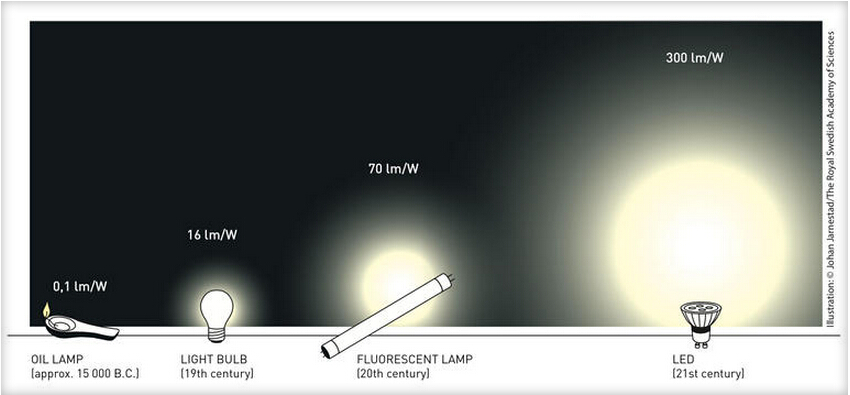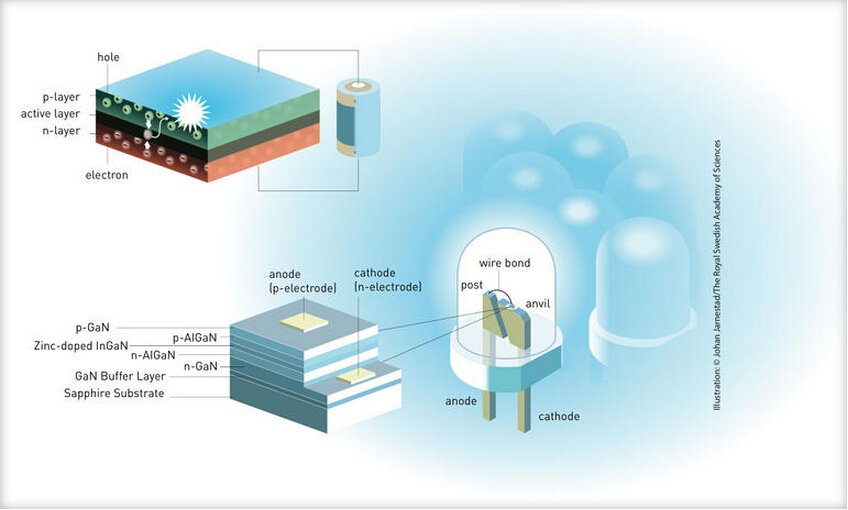Three researchers helped revolutionize lighting with vastly better energy efficiency and brightness. The light-emitting diodes also are used in data storage, TVs and smartphones.
Baffled by Higgs bosons, quantum mechanics, and the accelerating expansion of the universe? This year's physics Nobel Prize is for something that's reassuringly understandable and useful: the blue LEDs used in everything from home lighting and headlights to TV screens and traffic signals.
Three researchers received the 2014 Nobel Prize in physics on Tuesday for the invention of this blue light-emitting diode (LED), a technology now used in high-speed networking, data storage, smartphones, water purification, and efficient home illumination.
The winners are Isamu Akasaki, a Japanese citizen and professor at Meijo University and Nagoya University; Hiroshi Amano, a Japanese citizen and professor at Nagoya University; and Shuji Nakamura, an American citizen and professor at the University of California in Santa Barbara.
The key advantage of their invention 20 years ago is the production of light with far less waste of electrical energy than with preceding technologies like incandescent and fluorescent lights, the Royal Swedish Academy of Sciences said in awarding the prize.
"A quarter of energy consumption goes to illumination," said Per Delsing, a physics professor at the Chalmers University of Technology in Sweden, during a press conference announcing the award. As a result, any increase in efficiency and consequent saving of energy "is really going to have a big impact on modern civilization," he said.
Nobel Prizes in physics often go to fundamental discoveries such as the Higgs Boson. But when the committee makes an award for an invention, "we really emphasize the usefulness of the invention," said Anne L'Huillier, an atomic physics professor at Lund University in Sweden, also speaking at the press conference. And the blue LED is nothing if not useful.

Recent Nobel prizes have been awarded for concepts that are very far from day-to-day human experiences -- giant magnetoresistance, Bose-Einstein condensates, superconductors and superfluids, and the accelerating expansion of the universe, for example. The blue LED -- something you can buy at the local home-improvement store -- seems downright mundane by comparison.
But it's anything but ordinary, said H. Frederick Dylla, chief executive officer of the American Institute of Physics, who called the work a "tour de force" because it required a combination of materials science, physics, and chemistry. Indeed, the invention of the blue LED was on a short list of his institute's candidates for the prize, he said.
"It's a very expensive technology requiring atomic-layer epitaxy, where layers are put down atomic layer by atomic layer at a very high vacuum," Dylla said. It's vastly more complicated than incandescent lights, he added. "Compare that to drawing tungsten wire and putting it into a blob of glass and blowing out the air with some argon, and you have a light bulb for a few cents."
Three colors of LED
The white light from the sun can be reproduced artificially by blending three colors of light: red, green, and blue. LEDs are very efficient at converting electrical energy into visible light, but blue LEDs proved much harder to engineer than red and green ones. It took more than a quarter century after red LEDs were invented in the early 1960s before semiconductor materials and fabrication techniques grew sophisticated enough to enable blue LEDs in the mid-1990s.
White LEDs work either by packaging trios of red, green, and blue LEDs or by using just blue LEDs whose light also excites phosphors that emit green and red.
Now those white LEDs are spreading rapidly across the globe, led by lighting applications.
Incandescent lights -- the traditional Thomas Edison-era light bulb -- work by heating up a filament until it glows. That approach produces light, but most of the energy is wasted as heat.
Fluorescent bulbs are more than four times more efficient, a big step forward. But LEDs are nearly twenty times as efficient as incandescent bulbs, and they aren't saddled with the risky mercury-related health risks of fluorescent bulbs. As an added bonus, LED lights last longer, too.

White LEDs are now used widely in streetlights, traffic lights, flashlights, vehicle headlights, and as costs come down, home and office lights. They're also a major force in electronics, providing the light in screens in laptops, phones, tablets, and TVs.
Akasaki and Amano worked together on the technology at Nagoya University, while Nakamura at the time was working at Nichia Chemical Corporation. It took more than a decade of work to produce practical blue-LED designs in the 1990s.
The trio will split an award of about $1.1 million. That's a lot more than the $200 that Nichia paid Nakamura for his invention -- but less than the $8 million he won in 2005 in a lawsuit arguing that he deserved a bigger share of the royalties his invention brought in.
Basic science bears fruit
Dylla is happy to see a Nobel Prize awarded to something comprehensible to the public. But that doesn't mean scientific inquiry should be directed only toward products that have an obvious commercial or practical benefit, he said.
"I am troubled by some who say if the government funds research, it should only be...directed towards things that have a practical application," Dylla said. "The trouble with that limited view is that most of what ended up as practical applications of science have come from rather unfettered basic research on the nature of matter or how energy interacts with matter."
For example Einstein's famously mind-bending theory of general relativity may seem remote. But ignoring it would make navigation with today's GPS satellites "highly inaccurate."
"You can trace many advances in science and engineering that have obvious and immediate practical applications to a foundation of basic science," he said.
NEWSTAR LED CO., LIMITED
没有评论:
发表评论